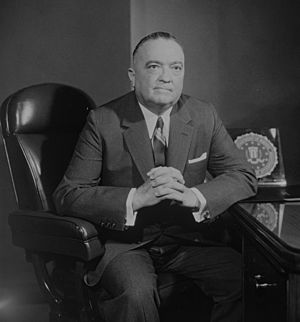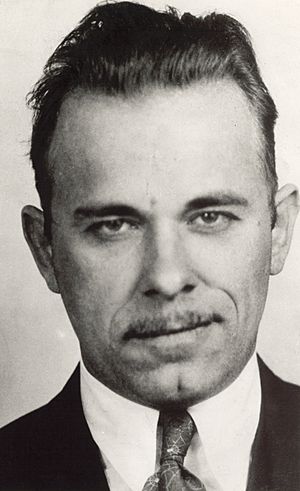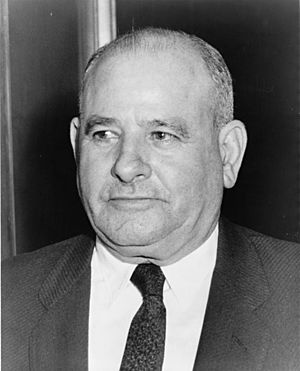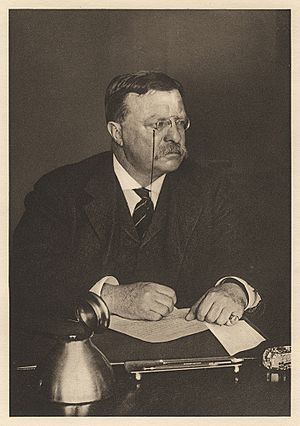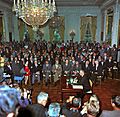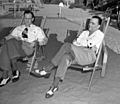J. Edgar Hoover facts for kids
Quick facts for kids
J. Edgar Hoover
|
|
|---|---|

J. Edgar Hoover in September 1961
|
|
| 1st Director of the Federal Bureau of Investigation | |
| In office March 22, 1935 – May 2, 1972 |
|
| President | Franklin D. Roosevelt Harry S. Truman Dwight D. Eisenhower John F. Kennedy Lyndon B. Johnson Richard Nixon |
| Deputy | Clyde Tolson |
| Preceded by | Office created (was BOI director) |
| Succeeded by | L. Patrick Gray (Acting) |
| 6th Director of the Bureau of Investigation | |
| In office May 10, 1924 – March 22, 1935 |
|
| President | Calvin Coolidge Herbert Hoover Franklin D. Roosevelt |
| Preceded by | William J. Burns |
| Succeeded by | Himself (as FBI Director) |
| Personal details | |
| Born |
John Edgar Hoover
January 1, 1895 Washington, D.C. United States |
| Died | May 2, 1972 (aged 77) Washington, D.C. United States |
| Alma mater | George Washington University |
| Signature | |
John Edgar Hoover (January 1, 1895 – May 2, 1972) was an American detective. He became the very first Director of the Federal Bureau of Investigation (FBI) in the United States.
Hoover was first appointed director of the Bureau of Investigation in 1924. This agency later became the FBI in 1935. He stayed in charge until he passed away in 1972 at 77 years old.
Many people say Hoover helped make the FBI a much stronger agency. He also brought in new police technologies. These included a central file for fingerprints and special labs for forensic science.
Later in his life and after he died, Hoover became a debated person. People found out he had used his power in secret ways that went too far. He was found to have gone beyond what the FBI was allowed to do. He used the FBI to bother political activists and collect secret files on leaders. He also gathered information using methods that were not legal. Because of this, Hoover gained a lot of power. He was even able to influence and challenge presidents.
Contents
Early Life and Education
John Edgar Hoover was born on New Year's Day in 1895. His birthplace was Washington, D.C.. His mother, Anna Marie, was of Swiss-German background. His father, Dickerson Naylor Hoover, Sr., had English and German family roots.
Hoover was closest to his mother, who taught him right from wrong. He lived in Washington, D.C., his whole life. He grew up near the Eastern Market.
He went to Central High School. There, he sang in the choir and was on the debate team. He was known for his "cool, relentless logic" in debates. As a boy, Hoover stuttered. He taught himself to speak very quickly to overcome this.
Leading the Bureau of Investigation
In 1921, Hoover became deputy head of the Bureau of Investigation. In 1924, he was made acting director. On May 10, 1924, President Calvin Coolidge officially appointed him as the fifth Director. This happened partly because the previous director was accused of being involved in a scandal.
When Hoover took over, the Bureau of Investigation had about 650 employees. This included 441 Special Agents. Hoover was known for being a very strict leader. He sometimes fired agents who displeased him. He also moved agents to less important jobs if they made him unhappy.
For example, Melvin Purvis was a very effective agent. He helped catch many famous criminals in the 1930s. Some say Hoover moved him out of the Bureau because he was jealous of Purvis's fame.
Fighting Gangsters in the 1930s
In the early 1930s, criminal gangs robbed many banks in the Midwest. They had powerful weapons and fast cars. This made it hard for local police to catch them. Many of these criminals were often in the news. John Dillinger was especially famous for escaping from jails.
These gangsters sometimes had public support. This was because banks were seen as unfair during the Great Depression. The robbers often crossed state lines. Hoover pushed for their crimes to be federal offenses. This would give his agents the power to chase them.
In July 1934, agents found Dillinger. He was ambushed and killed by FBI agents outside a movie theater. Hoover was given credit for catching or shooting many famous outlaws. These included Machine Gun Kelly in 1933, Dillinger in 1934, and Alvin Karpis in 1936. These events helped the FBI gain more power.
In 1935, the Bureau of Investigation was renamed the Federal Bureau of Investigation (FBI). Hoover helped expand the FBI's fingerprint files. He also helped create the FBI Laboratory in 1932. This lab helped examine and analyze evidence.
Focus on Organized Crime and Spies
During the 1930s, Hoover often said that organized crime did not exist. This was even though there were many shootings related to the Mafia and their control of illegal markets.
After World War II, Hoover focused more on fighting anti-communism. He seemed to ignore organized crime from the 1940s to the mid-1950s. He kept saying that no Mafia groups operated in the U.S. Later, people used this to criticize him.
Hoover was worried about what he called "subversion." This meant people trying to secretly harm the government. Under his leadership, the FBI investigated thousands of people suspected of being "subversives." Critics said Hoover often made these threats seem bigger than they were. They also said he went too far in trying to stop them.
Investigating German Spies
The FBI began investigating German spies in the late 1930s. They were mainly in charge of stopping enemy spying. The first German agents were arrested in 1938. Arrests continued throughout World War II.
During the war, German U-boats dropped off two groups of Nazi agents in Florida and Long Island. Their mission was to cause sabotage in the U.S. The FBI caught both teams after one of the agents told them everything.
President Roosevelt was worried about Nazi agents. He gave permission to wiretap people suspected of "subversive activities." He said the United States Attorney General had to know about each wiretap. The Attorney General left it up to Hoover to decide when and how to use wiretaps.
Secret Spy Discoveries
The FBI was part of the Venona Project. This was a secret project with the British before World War II. They listened in on Soviet spies in the UK and the United States. At first, they didn't realize spying was happening. But because the Soviets reused some secret codes, parts of their messages could be decoded. This showed that spying was taking place.
Hoover kept these secret messages in a locked safe in his office. He chose not to tell President Harry S. Truman or other top officials about them. He only told the Central Intelligence Agency (CIA) about the Venona Project in 1952.
In 1946, Attorney General Tom C. Clark allowed Hoover to make a list of Americans who might be disloyal. These people could be held during a national emergency. In 1950, when the Korean War started, Hoover gave President Truman a plan. It suggested holding 12,000 Americans suspected of disloyalty. Truman did not use this plan.
COINTELPRO and the 1950s
By 1956, Hoover was frustrated. The U.S. Supreme Court was making decisions that limited the government's power. This made it harder to prosecute people for their political views, especially communists. Some of his helpers said he made the threat of communism seem bigger. This was to make sure the FBI got money and public support.
Around this time, he started a secret program called COINTELPRO. This program was first used to disrupt the Communist Party USA. Hoover targeted people from suspected spies to famous figures like Charlie Chaplin. He believed they were spreading Communist ideas.
In the 1960s, Hoover's FBI watched John Lennon and Malcolm X. COINTELPRO tactics were later used against groups like the Black Panther Party. They were also used against Martin Luther King Jr.'s Southern Christian Leadership Conference. Hoover's actions against people connected to "subversive" groups, including those in the civil rights movement, led to accusations. People said he was trying to harm their reputations.
Hoover gained a lot of power by collecting secret files. These files had embarrassing information on many powerful people, especially politicians. COINTELPRO used methods like spying, breaking into places, illegal wiretaps, and spreading false rumors. This program continued until it was revealed to the public in 1971. A committee later said COINTELPRO's actions were illegal and against the Constitution.
Later Career and Death
Presidents Harry S. Truman and John F. Kennedy both thought about firing Hoover. But they decided it would cause too many political problems.
Hoover personally led the FBI's investigation into the assassination of President John F. Kennedy. In 1964, President Lyndon B. Johnson allowed Hoover to stay as FBI Director. This was even though Hoover was past the mandatory retirement age of 70.
When Richard Nixon became president in 1969, Hoover was 74. Many in Washington, D.C., felt the aging FBI chief should retire. But Hoover still had too much power and friends in Congress to be forced out.
Hoover remained director of the FBI until he died from a heart attack. He passed away at his home in Washington on May 2, 1972. Hoover's body was placed in the Rotunda of the U.S. Capitol. Chief Justice Warren E. Burger spoke highly of him there. President Richard Nixon also gave a speech at his funeral. Nixon called Hoover "one of the Giants" who had achieved great things for his country. Hoover was buried in the Congressional Cemetery in Washington, D.C.
Legacy

Biographer Kenneth D. Ackerman said Hoover built the FBI into a modern, national organization. He focused on professionalism and using science to fight crime. For most of his life, Americans saw him as a hero. He made the G-Man (FBI agent) so popular that it was very hard to become one.
Hoover worked to improve the FBI's image in the media. He advised Warner Bros. on a movie about the FBI called The FBI Story (1959). He also advised on the TV series The F.B.I. (1965). Hoover made sure Warner Bros. showed the FBI in a good light.
Because Hoover's actions were later seen as misusing power, FBI directors now have term limits. They can serve one 10-year term, which can be extended by the United States Senate. The FBI Headquarters in Washington, D.C., is named the J. Edgar Hoover Building after him.
Hoover's way of sometimes ignoring civil liberties for national security has been questioned. This is especially true with recent national surveillance programs.
Honors

- 1938: Oklahoma Baptist University gave Hoover an honorary doctorate.
- 1939: The National Academy of Sciences gave Hoover its Public Welfare Medal.
- 1950: King George VI of the United Kingdom gave Hoover an honorary knighthood.
- 1955: President Dwight D. Eisenhower gave Hoover the National Security Medal.
- 1966: President Lyndon B. Johnson gave Hoover the State Department's Distinguished Service Award.
- 1973: The new FBI headquarters in Washington, D.C., was named the J. Edgar Hoover Building.
- 1974: Congress voted to publish a memorial book about Hoover.
- 1974: A grade school in Schaumburg, Illinois, was named after J. Edgar Hoover. However, in 1994, after his illegal activities became known, the school's name was changed to honor Herbert Hoover instead.
Images for kids
-
Hoover investigated ex-Beatle John Lennon. This is a letter Hoover wrote to the US Attorney General in 1972.
-
July 24, 1967. President Lyndon B. Johnson (front) talks with (back L-R): Marvin Watson, J. Edgar Hoover, Sec. Robert McNamara, Gen. Harold Keith Johnson, Joe Califano, Sec. of the Army Stanley Rogers Resor, about the Detroit riots.
-
President Lyndon B. Johnson signing the Civil Rights Act of 1964. People watching include Attorney General Robert F. Kennedy, Rev. Martin Luther King Jr., and J. Edgar Hoover.
-
Hoover and his assistant Clyde Tolson sitting in beach lounge chairs, around 1939.
See also
 In Spanish: John Edgar Hoover para niños
In Spanish: John Edgar Hoover para niños


